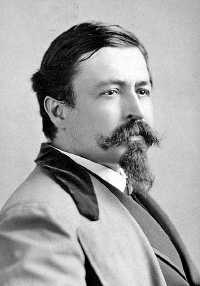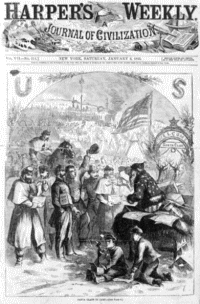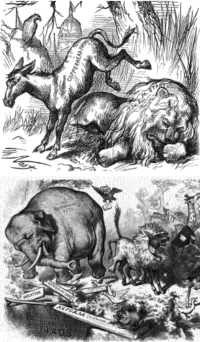 SKC Films Library SKC Films Library |
| SKC Films Library >> Fine Arts >> Pictorial Humor, Caricature, Etc. |
 Thomas
Nast Thomas
Nastillustrator and political cartoonist Thomas Nast was born in Landau, Bavaria, on September 27, 1840, the last child of Joseph Thomas and Appolinia Abriss Nast. His father, a trombonist in a regimental band, held political views that put him at odds with the government, so in 1846 he left Bavaria to enlist in the French navy and sent his wife and son to America; he joined them in New York City after his enlistment ended in 1850. Thomas entered the New York City public school system at the age of six, but his inability to speak English and intense dislike of school work made him a poor student and he was often in danger of flunking out. A neighbor made candles and crayons for a living and often gave Thomas reject crayons. Thomas clearly loved drawing more than studying, so when he was 12 the school master convinced his parents to pull him out of public school and enroll him into an art school. He spent about three years at the National Academy of Design before financial problems forced him to leave and seek employment. He found employment hard to come by, however, because he could not read or write and was not physically suited for manual labor. In 1855 Nast applied for a job as an illustrator for Frank Leslie's Illustrated Newspaper. He was promptly rejected, however, because he had never gone through an apprentice program (a prerequisite in those days). Undaunted, he kept returning until the publisher finally agreed to give him an assignment -- go down to the Christopher Street Ferry House in lower Manhattan during rush hour and draw a picture of the crowd boarding the ferry. Nast returned the next day with the completed drawing, and Leslie hired him on the spot; the drawing was never published. In 1858 Leslie's was forced to lay off several staff members, including Nast. After spending about a year working in an art studio, Nast decided to try his hand at political cartooning and created a drawing depicting the scandal then going on in the New York City Police Department. The drawing was published by Harper's Weekly on March 19, 1859. In 1860 the New York Illustrated News offered to double Nast's salary if he agreed to illustrate current events in Europe. Nast agreed, and in February was sent to cover the prize fight between John C. Heenan and Thomas Sayers. Nast's financial bonanza did not last, however, because the Illustrated News stopped paying him soon after. Stranded in London, Nast produced illustrations of Giuseppe Garibaldi's military campaign in Sicily for the Illustrated London News and other papers to raise money to get back to New York City. He returned in February 1861, and married Sarah Edwards on September 26. He and Sarah ultimately had five children, Julia, Thomas, Jr., Edith, Mabel, and Cyril. In 1862, after a brief return to Leslie's, Nast was rehired by Harper's Weekly, and he soon became one of that publication's most recognized and, sometimes, controversial illustrators.
In 1867, Nast created the "Grand Caricaturama," a series of 33 huge (eight feet by twelve feet) tempera paintings that comprised an allegory of the nation's recent history. The enormous pictures were rolled across a stage, accompanied by piano music and a satirical narrative presented by an actor. Presented in New York and Boston, the show was popular with both the press and the public, but was a financial failure.
The popularity of Nast's illustrations allowed him great freedom at Harper's Weekly, which knew that any restrictions on his work could easily lead to a reduction in circulation. That freedom ended, however, after magazine founder Fletcher Harper died in 1877 and was succeeded by nephews Joseph W. Harper, Jr. and John Henry Harper. The nephews supported editor George W. Curtis, who began refusing to publish anything contrary to his own political views, and Nast's drawings began appearing less often and never on the cover. Nast eventually became fed up with Harper's Weekly, and his last two engravings for that magazine appeared in its Christmas 1886 issue. After leaving Harper's Weekly, Nast focused on oil paintings, including oil renditions of many of his engravings. He also contributed illustrations to several magazines and newspapers, but his popularity had by then begun to wane and neither venture provided financial security. In 1892 he purchased the New York Gazette, an unprofitable weekly newspaper, and renamed it Nast’s Weekly. The paper failed after only six months, however, taking most of Nast's remaining money with it. Complete financial ruin was only barely avoided by commissions for oil paintings and book illustrations, and by 1902 Nast was desperate for steady work. In that year, President Theodore Roosevelt, a fan of Nast's work, named him Ambassador to Ecuador. Nast had been at this post for only a few months when he died of yellow fever on December 7, 1902. Originally buried in Ecuador, his remains were reburied in Woodlawn Cemetery, Bronx, New York, in 1906. NOTE: Despite using text as part of his illustrations, Thomas Nast never did learn to read or write.
SOURCES SEE ALSO |
| SKC Films Library >> Fine Arts >> Pictorial Humor, Caricature, Etc. This page was last updated on 05/12/2017. |



